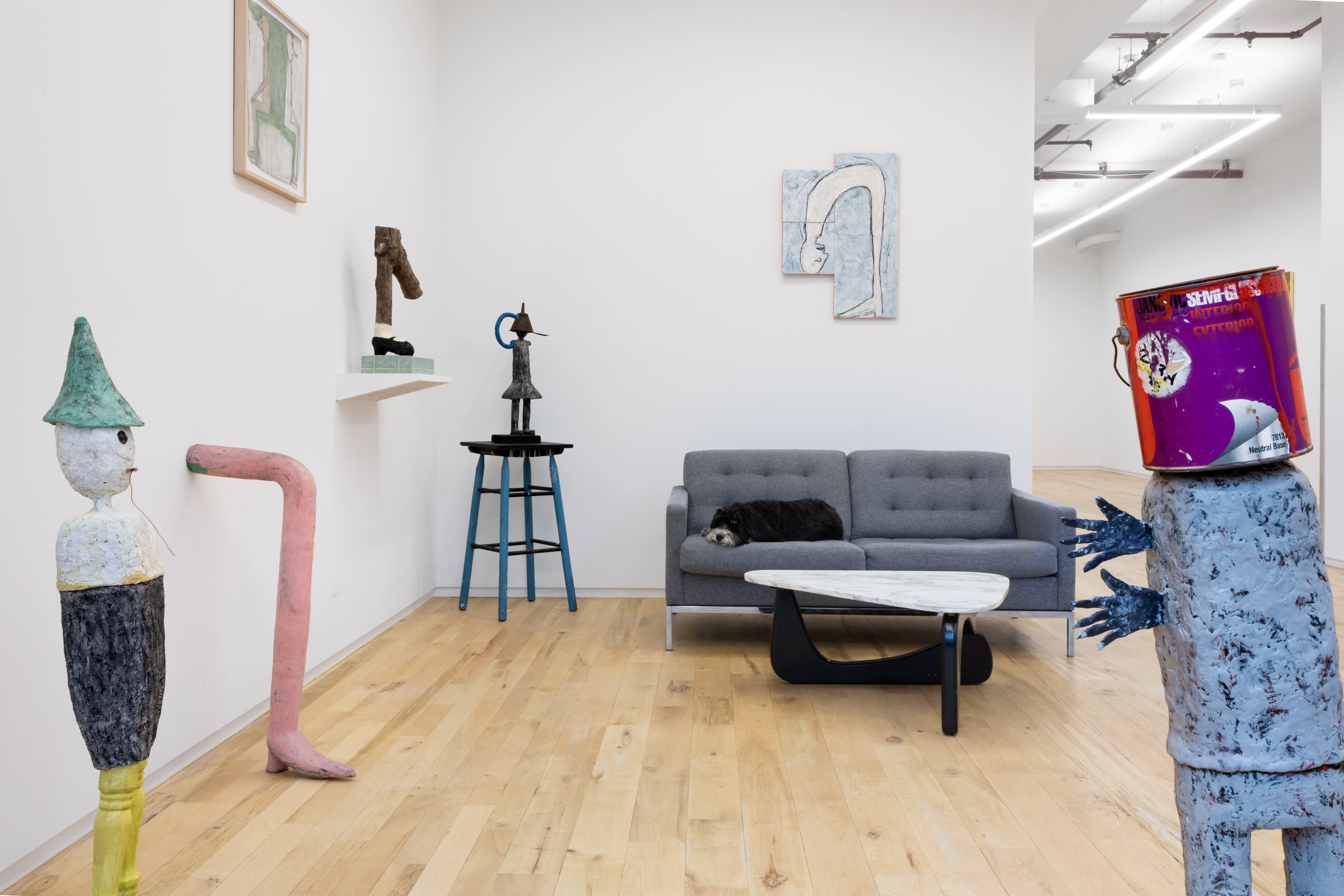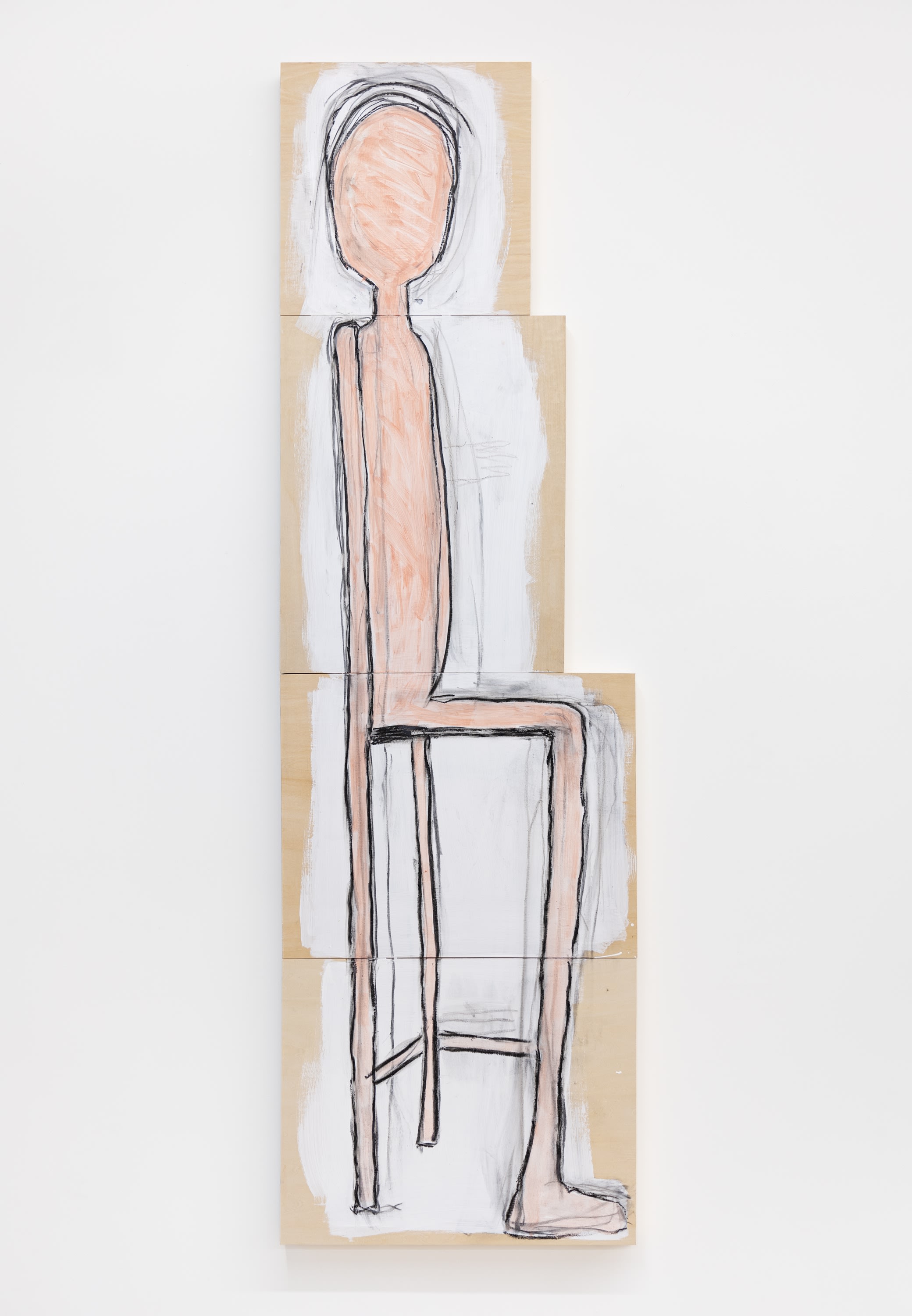October 14, 2024
In Melissa Stern: A Leg to Stand On, the domestic meets the fantastic in the aptly named The Living Room, the front room exhibition space at DIMIN complete with a cozy two-seater sofa. Featuring her drawings and sculptures, Stern’s trademark humor and sense of play persists while the underlying thread of darkness that pervades her oeuvre feels especially heightened in this presentation. Deeply shaken by a fall during a winter walk in 2021, the artist’s works in the exhibition explore the precarious and fragile construction of the human body. Cobbling together disparate elements such as vintage shoes, wooden branches, scrap pieces of bannister railings, a doll’s lost arm, linoleum, wallpaper, resin, clay, paint cans, bolts, and screws, Stern balances absurdity with familiarity.
Reminiscent of the emotive Island of Misfit Toys, A Leg to Stand On presents the artist’s works as a community of castoffs where nostalgia coalesces with unease. Evoking the sinister yet fantisful narrative of fairy tales, the anthropomorphic objects take on a character and life of their own. The works feel both at home in the space yet also like an odd band of vagabonds making their best attempt to blend in; however, their weird, quirky, misfit presence comedically sabotages that effort. Stern’s figures exhibit a consistent awkwardness mixed with violent undertones marked by gestures of wear and tear, highlighting their materiality and construction. Oftentimes missing parts of their whole, they stiffly teeter between imbalance and holding their own. At once comedic, their ominous placement in the space simultaneously imbues them with a hint of horror associated with animating seemingly inanimate objects, particularly in domestic realms.

Honing in on the distinct upright posture that distinguishes humans from most species, Stern omits a majority of facial features and distills the bodies into basic geometric shapes, unifying the forms in an androgynous sort of way. Vintage accessories such as Mary Janes, a lace-up black and white Oxford, and makeshift hats suggest token symbols of applied gender, an element of dress up and costume play. Sparsely and randomly outfitted in dated yet arguably classic fashions, many of the figures sport one shoe, the other conspicuously missing, one of many tells upending their futile attempt to assimilate with everyday gallery goers. Such is the case in Couple (2024), the sculptural pairing of two figures perched atop a storage cabinet to the left of the gallery desk. Here, the figure on the left of the duo has one sculpted shoe and one bare foot. Their partner sits upright on two limbs which serve as both arms and legs, resting on claw-like appendages whose appearance oscillates between hands or potentially the feet of an animal such as a bird. Sculpted lines in the limbs of this figure suggest mounds of matted fur or feathers yet also evoke tree bark. This theme of hybridity continues throughout the show as Stern scaffolds her figures employing elements of nature, domestic fabrication, industrial ephemera, nods to materiality and the studio process.
 Melissa Stern, Couple, 2024 Clay, resin, paint, objects, wire, steel, 29 x 24 x 11 in.
Melissa Stern, Couple, 2024 Clay, resin, paint, objects, wire, steel, 29 x 24 x 11 in.
Above the couple, a framed drawing titled Tangled (2023) features two figures seated on chairs placed some distance apart, their backs facing and connected by a shared head of hair pulled taut between that distance. This drawing offers a portrait commentary on the dynamic between not only the sculptural couple below but also dependent relationships overall, particularly between humans.
 Melissa Stern, Housebound, 2019, Clay, wood, paint. 23 x 10 x 9 in.
Melissa Stern, Housebound, 2019, Clay, wood, paint. 23 x 10 x 9 in.
In Sit, a drawing meets painting on four wooden panels, Stern renders a figure sitting, as though for a portrait, with arms elongated more than double their proportional length. The sitter’s arms lay straight down at their sides and extend all the way to the floor, forming the back legs of a tall, thin chair—the body doubling as its own support.
While these two works evoke entrapment, they also suggest mobility as the four plaques that make up Sit allow for easy transport and interchangeability of the work while in Housebound, the right foot angles out roughly 45 degrees, implying a pivot, Mary Janes and abode, covertly on the move.
Despite the stripped-down nature of the, at times absent, faces and mostly bare bodies, Stern’s objects emit a profuse range of emotion and movement through their form, color, graphic impulse, and gestures. Though the works elicit a dark strangeness, a sense of empathy balances this foreboding tone, much like a tragic comedy. Stern engages with our complicated collective relationship to our anatomy and its mutable, hybrid nature throughout the course of our lives as modern medicine and technology intervene in order to keep our bodies functioning in the event of their inevitable breakdown and mishaps. Furthermore, she taps into the weird elements of the psyche that also shape our bodily experience—we are constructed by not only the sum of our parts but also dreams forgotten upon waking, memories, repressed desires, and fears, inherited trauma and joy, and the humanizing baggage (and delight) of existence. The artist’s creations bring out not only a sense of empathetic recognition in the viewer but also empathize back, affirming a mutual plight by standing as both witness and testament to the endurance of the body and the spirit.
All photos courtesy of the gallery.
 Melissa Stern: A Leg to Stand On is open through October 19 at The Living Room at DIMIN gallery.
Melissa Stern: A Leg to Stand On is open through October 19 at The Living Room at DIMIN gallery.
About the writer: A.E. Chapman is an independent curator, writer, teaching artist, and facilitator based in New York City. She received her MA in Art History and an Advanced Certificate in Curatorial Studies from Hunter College where she was awarded the Edna Wells Luetz/Frederick P. Riedel Scholarship to support her masters studies based on her excellence in significant post-baccalaureate undergraduate coursework at Hunter in studio art and art history. Her masters coursework focused on modern and contemporary art within transnational networks and the Americas. She holds an undergraduate degree in Journalism with a Photojournalism Emphasis and a minor in Sociology from the University of Georgia.


